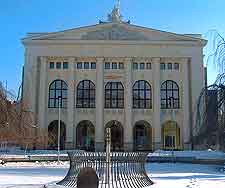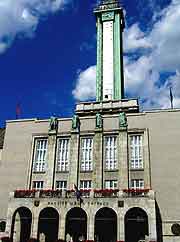Ostrava History Facts and Timeline
(Ostrava, North Moravia, Czech Republic)

The history of the Ostrava region is positively ancient, dating back somewhere in the region of 25 centuries. It is thought that this area was of particular importance during its prehistoric life, due to its proximity to the Amber Trail, a long-established trading route connecting Asia with Europe.
A number of important archaeological artefacts have been unearthed from the earliest days of Ostrava's beginnings. The famous tiny female torso sculpture now named the Petrkovice Venus was discovered here in the 1950s, next to the tooth of a woolly mammoth. Those wishing to admire the centuries-old Venus will need to make a trip to the Archaeological Institute of
Brno, where she resides today.
Origins of the City
History documents show that two sizeable settlements were based here by the arrival of the 13th century. The River Ostrá (Ostravice) provided an important boundary between the rival communities - the Moravians (Moravskás) and the Silesians (Slezskás). It is likely that Silesian Ostrava was the older of the two settlements, being first mentioned in the late 1220s, while Moravian Ostrava is not remembered in history for another four decades.
By the time that the 14th century arrived, the Silesians had a large fortress and an established hierarchy, while the Moravians were the first to officially enjoy town status. During the medieval expansion of the Germans, known as the Ostsiedlung, both sides of the river soon experienced a significant proportion of German inhabitants.

The Development of the Two Towns
Both of these two riverside towns remained relatively low-key and small, with populations in the region of 1,000 people each. Many of the locals engaged in handicrafts, trading their wares, while others focused their energies on agriculture.
Things were to change in a big way during the early part of the 1760s, when the town of Moravian Ostrava discovered that it was sitting on huge quantities of coal, which was just waiting to be mined. As a result, numbers quickly swelled with a steady stream of immigrants arriving, hoping to become a part of the booming coal industry and the subsequent period of industrialisation.
Many coal mines existed around Ostrava in the 19th centuries and the Moravian-Silesian Region soon became unified. For information about the city's coal mining history, tourists may like to check out the Museum of Coal Mining (Hornické Muzeum) on the Pod Landekem.
Formerly a simple farming village, adjacent Vitkovice soon joined in, becoming the home of a major iron and steelworks. Wealthy Austrian Salomon Mayer von Rothschild arrived and injected his capital into the iron and steel mills. He also funded a railway line to
Vienna, linking the busy Emperor Ferdinand Northern Railway (Kaiser-Ferdinands-Nordbahn).
History of the 20th Century Onwards
The Second World War was not kind to Ostrava, due to the city being such a major producer of steel, and so numerous bombs were dropped on its factories. As a result, areas of the city were devastated by the bombing damage and the subsequent reconstruction was slow.
More recently, the late 1980s saw the non-violent Velvet Revolution of Czechoslovakia mark a turning point in the evolution of Ostrava. The city's coal mines were closed a few years later and the Vitkovice steelworks soon followed suit, meaning that the previous problem of heavy pollution was greatly improved virtually overnight. The past few decades have seen substantial population increases and decreases, and the city is now home to just over 300,000 people.
Tourism has made itself known in the city in recent years, with the Silesian Ostrava Castle being a major highlight, along with St. Wenceslas Church.
 The history of the Ostrava region is positively ancient, dating back somewhere in the region of 25 centuries. It is thought that this area was of particular importance during its prehistoric life, due to its proximity to the Amber Trail, a long-established trading route connecting Asia with Europe.
The history of the Ostrava region is positively ancient, dating back somewhere in the region of 25 centuries. It is thought that this area was of particular importance during its prehistoric life, due to its proximity to the Amber Trail, a long-established trading route connecting Asia with Europe.